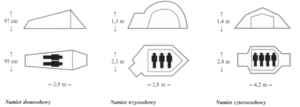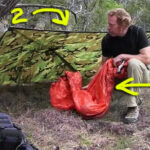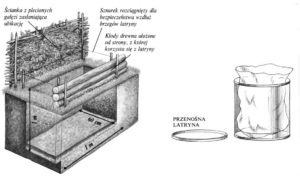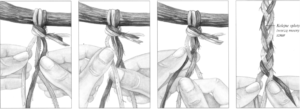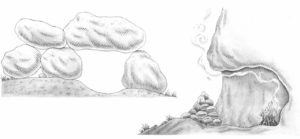Rozbijanie namiotu
Wybierając miejsce na biwak decydujemy równocześnie, gdzie rozbijemy namiot uwzględniając rozmieszczenie innych istotnych punktów obozowiska oraz zwracając uwagę na bezpieczeństwo naszego tymczasowego schronienia. Na początku należy ustalić, w którą stronę powinno być zwrócone wejście oraz w jaki sposób przymocujemy linki naciągające. Następny krok to przygotowanie miejsca pod namiot – oczyszczenie podłoża, usunięcie gałęzi, kamieni i wszelkich nierówności. Najpierw rozbij namiot, potem zajmij się innymi pracami związanymi z zakładaniem obozowiska. Przy ustawianiu namiotu, podobnie jak i przy wykonywaniu innych czynności staraj się postępować za każdym razem wedle tego samego, z góry ustalonego planu. Z czasem kolejne wykonywane czynności wejdą Ci w krew. Taka rutyna okazuje się niezwykle przydatna, na przykład wtedy gdy trzeba rozbijać namiot po ciemku. Musisz mieć również pewność, że stawiając namiot, znajdziesz bez trudu każdy z jego elementów. Dlatego też tak ważne jest systematyczne składanie namiotu i pakowanie go.
 1 Rozbijaj zawsze namiot tak, jakbyś to robił przy szalejącym wietrze. Najpierw rozłóż sypialnię na ziemi i natychmiast przymocuj podłogę zaczynając od rogów.
1 Rozbijaj zawsze namiot tak, jakbyś to robił przy szalejącym wietrze. Najpierw rozłóż sypialnię na ziemi i natychmiast przymocuj podłogę zaczynając od rogów.
2 Złóż maszty namiotu. Uważaj, by łączyć sobą odpowiednie części masztów, w przeciwnym raz możesz mieć później problemy z rozłożeniem. Krótszy maszt wetknij w kółko i zatyczki z tyłu namiotu.
3 Podnieś krótszy maszt do góry i przymocuj koniec biegnącej od niego linki do ziemi. Naciągnij ją tak, by maszt stał pionowo. Zwróć uwagę, aby tył namiotu zwrócony był w stronę, skąd przeważnie wieje wiatr.
4 Przełóż czubek dłuższego masztu przez otwór z przodu namiotu. Podnieś maszt i napnij linkę naciągającą. Wykonaj te czynności szybko. Przy silnym wietrze namiot podczas stawiania jest niestabilny, a gdy pada, nieimpregnowana sypialnia szybko przemoknie.
5 Naciągnij tropik na sypialnię zaczynając od tyłu namiotu. Następnie przymocuj tył tropiku za pomocą śledzia w ziemi.
6 Naciągnij tropik na cały namiot nakładając go przez otwór z przodu na wyższy maszt. Przytwierdź przód tropiku śledziami. Możliwe, że będziesz musiał przesunąć linkę naciągającą sypialnię w stronę masztu, żeby dało się prawidłowo rozpiąć poły tropiku.
Wyciągając źle wbite śledzie lub szpilki nie ciągnij za linki namiotu. Mogą się zerwać. Wyjmując śledzie z ubitej ziemi, można się posłużyć innymi śledziami lub specjalnym hakiem.
 7 Zasuń zamek błyskawiczny tropiku zamykając jego poły nad linką naciągającą przód namiotu. Przestrzeń między sypialnią a połami tropiku tworzy przedsionek, w którym można przechowywać żywność i sprzęt.
7 Zasuń zamek błyskawiczny tropiku zamykając jego poły nad linką naciągającą przód namiotu. Przestrzeń między sypialnią a połami tropiku tworzy przedsionek, w którym można przechowywać żywność i sprzęt.
8 Naciągnij linki z boków sypialni i umocuj je w ziemi śledziami lub szpilkami. Pamiętaj, by ścianki z obu stron namiotu były jednakowo naprężone.
9 Umocuj ścianki tropiku wbijając w ziemię przetknięte przez gumki śledzie. Zwróć uwagę, by dobrze były naciągnięte i nie stykały się ze ściankami sypialni.
10 Rozepnij poły tropiku i regulując naprężenie linek wyrównaj naciąg namiotu w ten sposób, by był stabilny, a na ściankach nie tworzyły się luźne fałdy. Pamiętaj jednak, aby linki również nie były zbyt mocno naciągnięte.
11 Tył namiotu powinien być skierowany w stronę, skąd przeważnie wieje wiatr. I tropik, i sypialnia muszą mieć dobrze naciągnięte ściany, żeby stanowiły skuteczną
ochronę przed wiatrem i deszczem. Plecaki można trzymać w przedsionku, nigdy nie należy przechowywać w namiocie nie zapakowanej żywności.
PRAKTYCZNE WSKAZÓWKI
■ Zimą zawsze należy używać zarówno sypialni, jak i tropiku. W innych porach roku, w ciepłym klimacie można się obyć bez podwójnej osłony. Spanie pod samym tropikiem zwiększa ilość miejsca wewnątrz namiotu.
■ Bardzo istotna jest odpowiednia wentylacja wnętrza namiotu. Nigdy nie gotuj jedzenia w środku, możesz to robić w przedsionku, przy uchylonych połach tropiku.
■ Na kamienistym gruncie śledzie i szpilki mogą uszkodzić się. W takim wypadku należy linki naciągające przywiązać, na przykład do dużych odłamków skalnych.
■ Między tropikiem a sypialnią powinien być odstęp, który sprawia, że tworzy się izolująca warstwa powietrza. Dlatego też trzeba odpowiednio mocno naciągnąć ścianki tropiku, by nie stykały się ze ściankami sypialni. W miejscu zetknięcia powstają mokre plamy, ponieważ na wewnętrznej stronie sypialni skrapla się para wodna. Woda zaczyna ściekać po ściankach, co grozi zamoknięciem śpiwora i innego sprzętu przechowywanego w namiocie.


